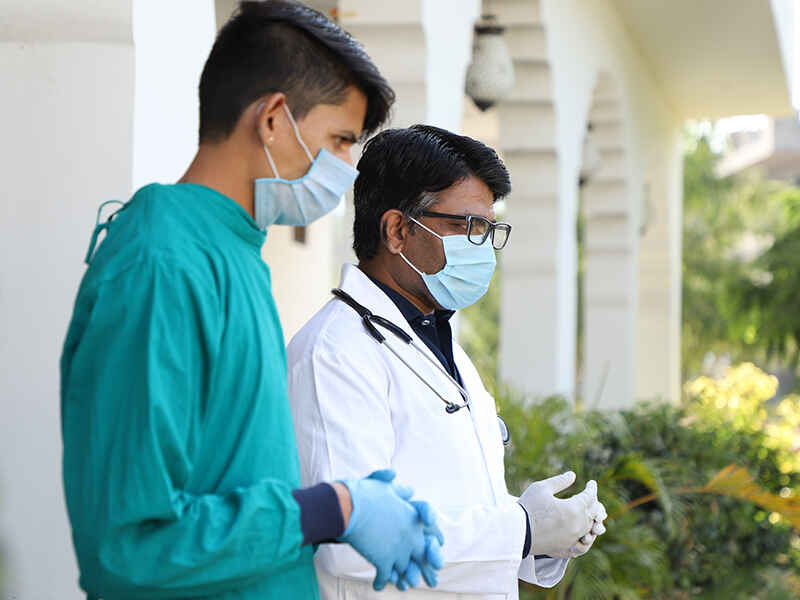The Nipah Virus (NiV) is an emerging infectious disease of zoonotic origin, meaning it is transmitted from animals to humans. This virus is carried primarily by fruit bats, which are known as the natural reservoir. It was first identified in Malaysia in 1999, and since then, outbreaks have occurred periodically, causing severe illness and death in humans, particularly in Southeast Asia. With a fatality rate ranging from 40% to 75%, the Nipah Virus remains a critical public health concern. There are no known vaccines or specific treatments, making awareness, early diagnosis, and prevention crucial in combating this disease.
The aim of this blog is to provide comprehensive information on the Nipah Virus, covering its causes, symptoms, treatment options, and prevention strategies. By the end of this blog, you will have a deeper understanding of the virus and the steps that can be taken to prevent its spread.
Read More: Viral Infections: Understanding The Types, Symptoms, And Cure
Table of Contents
What Is The Nipah Virus?

Nipah Virus (NiV) belongs to the Henipavirus genus in the family Paramyxoviridae. It was first discovered during an outbreak in Malaysia in 1998-1999, which primarily affected pig farmers. The virus is zoonotic, meaning it is transmitted from animals to humans, but human-to-human transmission can also occur. Since its discovery, outbreaks have been reported in Bangladesh and India, raising concerns about its pandemic potential.
Natural Hosts of the Nipah Virus
Fruit bats, particularly those from the Pteropus species, are the primary carriers of the Nipah virus. These bats often shed the virus in their saliva, urine, and excreta, contaminating fruits or other foods that humans or animals might consume. Pigs are also susceptible to infection, and their close contact with humans in farms has led to the spread of the virus in several outbreaks.
Key Facts:
Transmission: From animals (especially bats and pigs) to humans, human-to-human transmission, and through contaminated food.
Natural Hosts: Fruit bats (Pteropus species).
Primary Regions: Malaysia, Bangladesh, India (Kerala).
Early Symptoms (3 to 14 days):
– Fever and headache
– Muscle pain and sore throat
– Nausea, vomiting, and diarrhea
– Fatigue and drowsiness
Severe Symptoms:
– Encephalitis (inflammation of the brain)
– Seizures and confusion
– Coma (in extreme cases, encephalitis can lead to coma within 24-48 hours)
– Acute respiratory distress and difficulty in breathing
The incubation period for the virus typically ranges from 4 to 14 days but can extend up to 45 days in rare cases. The fatality rate of Nipah virus is alarmingly high, between 40% and 75%.
Diagnosis Of Nipah Virus
Early diagnosis of Nipah Virus is crucial, as it can prevent the spread of the disease and allow for better patient management. However, diagnosing Nipah Virus can be challenging because its early symptoms mimic those of other viral infections like influenza or dengue. The following diagnostic tools are typically used:
Clinical Evaluation
A detailed medical history, including recent travel to Nipah-affected areas or exposure to bats or pigs, can help narrow down the diagnosis. Doctors will look for neurological symptoms such as confusion or seizures, which are key indicators of encephalitis caused by Nipah Virus.
Laboratory Tests
1. RT-PCR (Real-Time Polymerase Chain Reaction): A highly sensitive and specific test that can detect Nipah Virus RNA in samples like blood, urine, throat swabs, and cerebrospinal fluid.
2. ELISA (Enzyme-Linked Immunosorbent Assay): Used to detect antibodies against the virus in the blood. This method is useful in both acute and convalescent phases of the disease.
3. MRI or CT Scans: Imaging techniques are used to assess brain inflammation, especially in cases where encephalitis is suspected.
Timely diagnosis can be the difference between life and death for Nipah Virus patients, making it essential for medical professionals to be aware of the signs and have access to advanced diagnostic tools.
Treatment For Nipah Virus
Currently, there are no specific antiviral treatments or vaccines for Nipah Virus. The treatment provided is primarily supportive, focusing on managing symptoms and preventing complications. However, research is ongoing, and experimental therapies are being investigated.
Supportive Care
Patients with Nipah Virus require intensive care to manage severe respiratory and neurological symptoms. Supportive care includes:
– Mechanical Ventilation: For patients suffering from acute respiratory distress.
– Intravenous Fluids: To maintain electrolyte balance and prevent dehydration.
– Symptom Management: Medications to manage fever, seizures, and pain.
Experimental Treatments
While there is no approved antiviral treatment for Nipah Virus, some experimental treatments are being explored:
1. Ribavirin: An antiviral drug that has been tested during past outbreaks, but its efficacy remains inconclusive.
2. Monoclonal Antibodies (m102.4): These antibodies have shown potential in neutralizing the virus in animal studies and are currently under research for human use.
3. Vaccines: Although there is no vaccine for Nipah Virus as of now, the Coalition for Epidemic Preparedness Innovations (CEPI) and other organizations are working towards developing a vaccine.
Is Nipah Virus Contagious?
Yes, the Nipah Virus is highly contagious, particularly during outbreaks. Transmission can occur through various modes, making it a significant public health threat. Understanding how the virus spreads is critical to controlling and preventing outbreaks.
Contagious Period
Nipah Virus is most contagious during the symptomatic phase of the infection. Individuals showing fever, coughing, or respiratory distress are more likely to transmit the virus. However, transmission can occur even before severe symptoms manifest, which increases the difficulty of containing outbreaks.
Modes of Transmission
1. Animal-to-Human Transmission: The primary transmission mode is through direct contact with infected animals, particularly fruit bats (Pteropus species) and pigs. Humans can become infected by consuming fruits contaminated with bat saliva or urine or by handling infected pigs.
2. Human-to-Human Transmission: Human-to-human transmission of the Nipah Virus was first documented during outbreaks in Bangladesh and India. Close contact with bodily fluids (such as saliva, blood, urine, or respiratory droplets) of infected individuals can lead to infection. This transmission mode is particularly concerning in healthcare settings, where doctors, nurses, and caregivers treating patients may become infected if proper precautions are not taken.
3. Fomites (Contaminated Surfaces): The virus can survive on surfaces contaminated by bodily fluids. Therefore, individuals can contract the Virus by touching surfaces or objects contaminated with it and subsequently touching their mouth, nose, or eyes without proper hand hygiene.
Preventive Measures To Reduce Contagion
– Isolation of Infected Individuals: Patients diagnosed with Nipah Virus must be isolated to prevent the virus from spreading to others, especially healthcare workers and family members.
– Use of Personal Protective Equipment (PPE): Healthcare professionals and caregivers should wear protective clothing, including gloves, masks, and face shields, to prevent exposure to infected bodily fluids.
– Hygiene Practices: Regular hand washing and disinfection of surfaces can significantly reduce the risk of contracting the virus from contaminated surfaces.
By understanding how contagious the Nipah Virus is and how it spreads, communities and healthcare systems can better protect themselves during outbreaks.
Prevention of Nipah Virus
Given the lack of specific treatments or vaccines, prevention remains the best strategy to reduce the risk of Nipah Virus outbreaks. Public health measures, proper hygiene practices, and avoiding high-risk behaviors are crucial in preventing the spread of the virus.
Preventive Measures for Individuals
1. Avoid Contact with Infected Animals: Individuals in affected areas should avoid contact with bats and pigs, which are the primary carriers of the virus. This includes refraining from eating fruits that bats may have contaminated.
2. Avoid Consumption of Raw Palm Sap: In regions where palm sap is consumed, people should ensure it is collected and stored safely, as bats can contaminate it.
3. Practice Good Hygiene: Regular hand washing, especially after handling animals or visiting markets, can reduce the risk of transmission.
Public Health Measures
Governments and health authorities play a vital role in preventing Nipah Virus outbreaks by:
– Surveillance and Contact Tracing: Monitoring individuals who may have been exposed to the virus and isolating those showing symptoms.
– Quarantine of Affected Areas: During outbreaks, controlling the movement of people and animals from affected regions can prevent further transmission.
– Public Education Campaigns: Raising awareness about how Nipah Virus spreads and the importance of reporting symptoms early can help limit the virus’s impact.
Nipah Virus Outbreaks in India
India, particularly the state of Kerala, has seen multiple outbreaks of the Nipah Virus in recent years. These outbreaks have been met with aggressive public health measures to contain the virus and limit its spread.
Key Outbreaks in India
1. Siliguri, West Bengal (2001): One of the earliest outbreaks, with a fatality rate of over 60%. The virus spread through hospital transmission, infecting patients and healthcare workers.
2. Kerala Outbreak (2018): The outbreak was traced to a family in Kozhikode, Kerala, and spread rapidly, claiming 17 lives. This outbreak was controlled through prompt isolation, contact tracing, and public health awareness.
Global Efforts to Combat Nipah Virus
The World Health Organization (WHO) and various other health organizations are closely monitoring Nipah Virus outbreaks and working towards creating a framework for preparedness. Collaborative efforts between countries, scientists, and research institutions are essential to understanding the virus better and developing vaccines and treatments.
Some key global initiatives include:
– The Nipah Virus Taskforce: A global team of researchers focused on studying the virus’s transmission patterns, host reservoirs, and outbreak triggers.
– One Health Approach: This strategy integrates human, animal, and environmental health to predict and mitigate outbreaks of zoonotic diseases like the Nipah Virus.
The Role of Crowdfunding in Nipah Virus Outbreaks
During outbreaks like Nipah, the healthcare system often becomes overwhelmed, and the costs of treatment, protective equipment, and emergency care can strain resources. Crowdfunding has emerged as a powerful tool in addressing these financial challenges. Platforms like ImpactGuru have enabled individuals and communities to raise funds quickly to support patients, purchase essential medical supplies, and provide aid to affected families. By harnessing the power of collective giving, crowdfunding ensures that even during unexpected health crises like the Nipah Virus outbreak, those in need can access life-saving treatments and support without the burden of overwhelming medical expenses.
Conclusion
The Nipah Virus is a deadly, zoonotic disease with significant pandemic potential. While outbreaks have been limited primarily to Southeast Asia, the increasing overlap between human and animal habitats, global travel, and climate change raise concerns about future outbreaks. As of now, prevention is the best approach, with awareness, early detection, and effective public health measures being crucial in controlling the spread of the virus. Scientists worldwide are working towards creating effective treatments and vaccines, but until then, personal vigilance and public health efforts remain our most vital defense against this dangerous virus.
Staying informed about the causes, symptoms, treatment options, and preventive measures can help individuals protect themselves and their communities.












